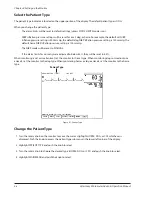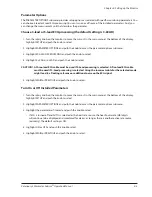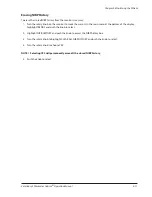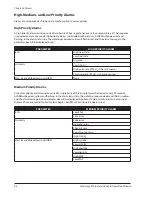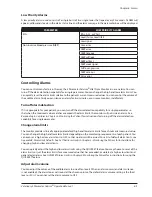
Chapter 5: Monitoring the Patient
5-6
Veterinary 3 Parameter Advisor
®
Operation Manual
The newly reset alarm limit will be displayed in the parameter box.
If a current measured value is not available, no changes will be made with QUICKSET.
•
If a high or low alarm limit is set to OFF, no changes will be made with QUICKSET.
•
If a QUICKSET high number (QS HI) or QUICKSET low number (QS LO) is set to NO CHG (no change), the
•
alarm limit will not be reset with QUICKSET.
The Advisor
®
Vital Signs Monitor provides a clinically appropriate range of selectable high and low alarm limits
for each measured value. Typically, the final choice at the upper end of each range of high alarm limits is OFF, and
the final choice at the lower end of each range of low alarm limits is OFF. Regardless of the QUICKSET high and
low numbers, a high or low alarm limit will never be reset to OFF when you select QUICKSET. The alarm limit will
be reset to the final value at the end of the range of high or low alarm limits. See the following example:
SELECTABLE HIGH AND LOW
ALARM LIMIT RANGES
QUICKSET
NUMBERS
PATIENT’S CURRENT
MEASURED VALUES
HIGH AND LOW ALARM
LIMITS AS RESET USING THE
QUICKSET FEATURE
Heart Rate
High: 20 – 350 bpm/OFF
Low: OFF/20 – 350 bpm
QS HI: +25
QS LO: -25
Heart rate: 44 beats per
minute (bpm)
High: 77
Low: 20
Since the minimum value for
a low alarm limit is 20, 27 bpm
is not an option (44 – 25 < 20).
QUICKSET will not reset the low
alarm limit to less than 20, or
OFF.
To set the QUICKSET high and low numbers:
Turn the rotary knob on the monitor to move the cursor. On the main menu at the bottom of the display,
1.
highlight ALARMS and push the knob to select.
Highlight CHANGE CURRENT ALARM LIMITS and push the knob to access the alarm limit box.
2.
Turn the rotary knob to highlight the name of the current measured value and push the knob to select.
3.
Highlight the QS HI or QS LO and push the knob to select.
4.
Turn the rotary knob to choose the desired number and push the knob to select. If you do not want a high
5.
or low alarm limit to change when you use the QUICKSET feature, select NO CHG (no change).
Turn the rotary knob to move the cursor back to the name of the measured value and push to select.
6.
NOTE! Be sure that the QUICKSET alarm limits you select are clinically appropriate for your patient.
Highlight MENU in the alarm limit box and push the knob to select.
7.
Highlight MAIN MENU and push the knob to select.
8.



